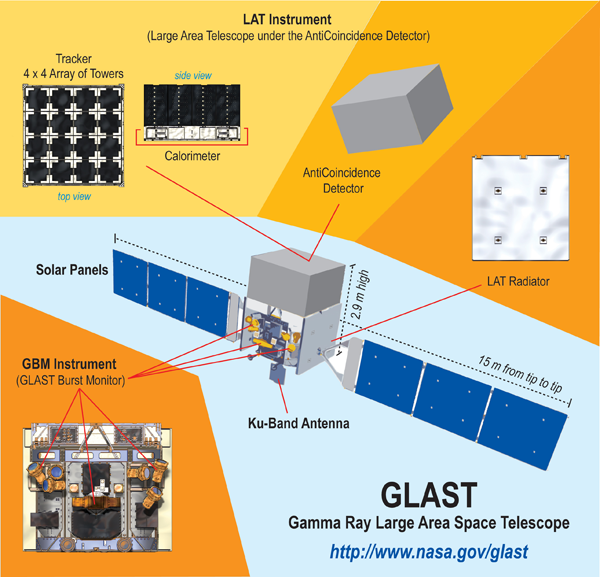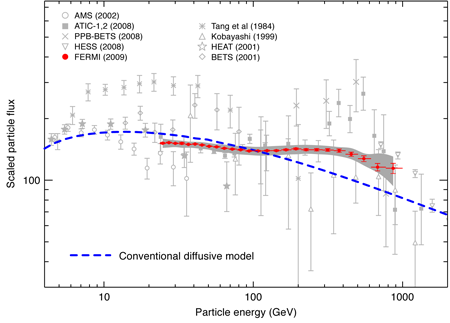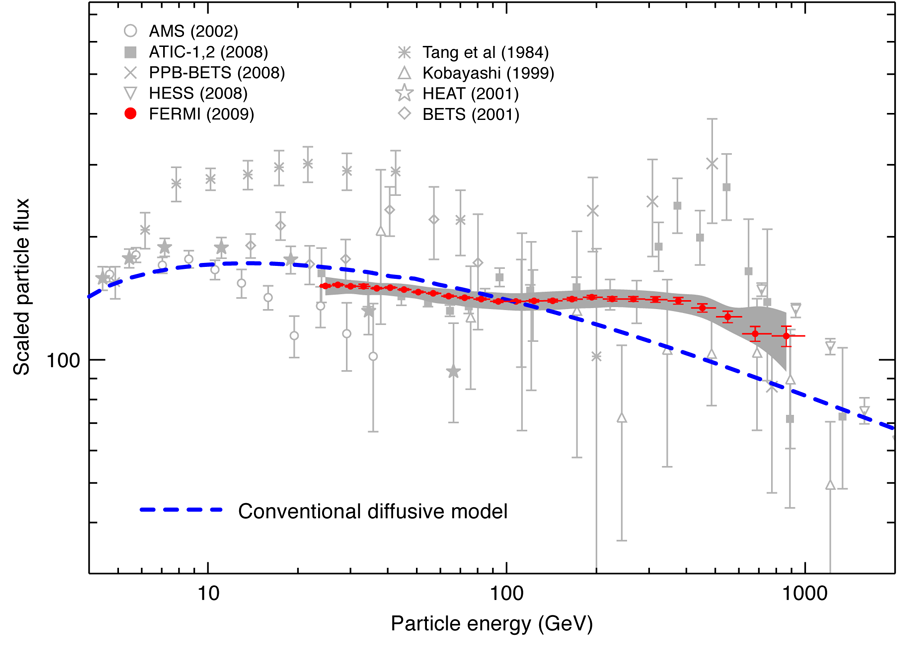Cosmic light matter probes heavy dark matter
There has been much recent interest in an excess of cosmic-ray electrons and positrons observed by the PAMELA [1] and ATIC [2] experiments. A large part of the excitement is the possibility that such a flux could be explained by dark matter (DM) in a nearby halo annihilating and producing excess electrons and positrons. Now in Physical Review Letters, a team of researchers reports new results from the Fermi Large Area Telescope that shed new light on whether such effects are from DM annihilations or less exotic astrophysical phenomena [3].
The existence and nature of dark matter is one of the most challenging puzzles in physics and cosmology. From observing astrophysical objects, cosmologists have gleaned that this dark matter represents some of the total energy of the universe, while “ordinary” matter—primarily the chemical elements—weighs in at only about . Although they make up a large fraction of the energy of the universe, DM particles interact with ordinary matter only very weakly, making their detection via interactions with ordinary matter difficult. Because they have been so elusive, an observation of these particles through ordinary matter interactions would be a giant leap forward.
Many of the most compelling ideas about the nature of the DM particles place their mass at 100 to 1000 times the proton mass ( ). For DM particles in this mass window, there are three avenues of exploration. The first is to produce the particle directly in the laboratory, one of the major goals of the Large Hadron Collider at CERN. The second is to directly detect the particle in a (usually) underground laboratory: a DM particle bounces off a nucleus in a very sensitive detector, and the small recoil energy is observed. The third is to see the products of the annihilations of such particles by means of detectors on the ground or in space.
This third technique is the one relevant for the ATIC, PAMELA, and now Fermi, results. Since DM particles gravitationally cluster both at the centers of galaxies and in smaller, nearer clumps, their densities are often high enough that they can annihilate, and the products of the annihilation, whether in the form of photons, electrons, positrons, or protons, will carry energies in the range of the DM mass. The PAMELA experiment (carried on a European Space Administration satellite) has observed electrons and positrons with energies in the – range, while the ATIC balloon experiment (with two flights at the south pole) has observed the total flux of electrons plus positrons (because the experiment cannot determine charge) in the – range. Considering electrons and positrons from, e.g., interactions of cosmic rays in the interstellar medium, one expects a featureless distribution falling with energy. PAMELA, however, saw a rise in the ratio of positron to electron-plus-positron fluxes, and ATIC saw a feature in the total flux consistent with a rise and sharp fall in the flux.
These excesses taken together may be explained by annihilating DM with a mass in the range, though there are some astrophysical sources, such as pulsars, which may also explain the excess. The Fermi spacecraft instruments are sensitive to such an excess, with its rising and falling features. Like ATIC, Fermi is unable to distinguish the charge of electrons and positrons, but is sensitive to the overall flux in the same energy range as ATIC, though with much more statistical significance. It can thus test the ATIC result, and determine whether its source may be annihilating DM.
The Fermi experiment was designed to measure photons; their first result relevant to DM was a measurement of the photon spectrum in the – range [4]. Earlier measurements from EGRET, which prompted much speculation by reporting an excess in that energy range, turned out to be instrumental in origin [5].
Fermi detects photons through electron-positron pair production in its detector layers (Fig. 1). The Fermi experiment is thus well equipped to observe cosmic-ray electrons and positrons. The challenges in such experiments are primarily in three areas: discriminating between positrons and the much larger proton background to the level of one part in ; understanding the electron efficiency sufficiently well so that the acceptance of the detector is well known; and knowing how to calibrate the electromagnetic calorimeter that measures particle energy.
The ideal way to accomplish these goals would be to have a magnetic spectrometer (to measure the particle momentum), a deep calorimeter (to measure the electromagnetic component of the energy), and a transition radiation detector (to ensure that the incident particle is of sufficiently high velocity). This is difficult in space, especially when the goal is to study rare events. The Fermi group elected to do the best job they could with the electromagnetic calorimeter, capitalizing on the differences between both the transverse and longitudinal development of hadronic and electromagnetic showers. They did extensive simulations, supported by specific beam tests of the calorimeter response versus energy for both electrons and protons.
In their paper Abdo et al. present results on the electron flux over the energy range of to (Fig. 2). The statistical errors on the points range from about to . The systematic errors are about up to about and then increase to just under in the highest energy bin. These results are then the most precise in this energy range. They are in conflict with the large excess in flux in the range reported by the ATIC collaboration. However, in the Fermi data there is good evidence for a small enhancement in flux in the higher energy range but the collaboration is for now taking a conservative position by adding the systematic errors without regard to their correlations; when doing so, they get an acceptable fit to a pure power-law behavior. A fuller account of the analysis will be included in a forthcoming paper.
These results, as precise as they are, do not definitively confirm or rule out a DM source. Although the large ATIC excess, which had been consistent with PAMELA, is ruled out, because of uncertainties from charge-dependent modulation in the flux from the solar wind, the Fermi and PAMELA data do remain consistent as having the same source. Since several natural astrophysical explanations can generate the Fermi and PAMELA spectra, the likely course is that one will be found there. It may simply be, as the Fermi paper points out, that the primary electron spectrum in the cosmic-ray source, predicted to fall as (where is the particle energy), does not fall as steeply as thought in the energy range observed by Fermi.
For example, secondary production in the supernova shock through the same mechanism that accelerates the cosmic-ray primaries can give rise to an spectrum, as observed by Fermi, falling less quickly than the primary spectrum up to [6]. Acceleration in the supernova shock in the polar cap was also speculated by Biermann et al. [7] to give a spectrum in the energy range probed by ATIC and Fermi, with a softer spectrum below and above . Both these mechanisms predict the PAMELA rise in flux ratio at lower energies. Thus within supernovae and supernovae remnants, there may be good reason to believe that the spectrum falls less steeply than had been predicted by the standard cosmic-ray model. As noted by the Fermi collaboration, the deviation from the standard spectrum is well fit by the addition of a power law with exponential cutoff, as might be expected from an additional nearby source of electrons and positrons. A pulsar, which could also explain the PAMELA data, might generate such a flux of electrons and positrons [8]. If a single such pulsar produces the excess , Fermi ought to be able to detect a anisotropy in the electron flux.
The excess over the standard cosmic-ray model may also come from annihilating dark matter, and its spectrum, like that from an astrophysical source, can be well fit by a power law with exponential cutoff. The spectrum from annihilating dark matter can also be well fit by a power law with exponential cutoff. That exciting scenario needs to satisfy constraints on the size of the annihilation cross section, on the measured flux, and on limits on hard photons from HESS and EGRET, but these are better accommodated with the more mild excess observed by Fermi and PAMELA than they were with the ATIC results.
Are the Fermi and PAMELA fluxes the result of DM annihilation, or do they come from a more pedestrian astrophysical source? Fermi will collect perhaps a factor of 10 more data on electrons, allowing measurements to perhaps , and there should be additional PAMELA data. The Alpha Magnetic Spectrometer (AMS) collaboration has a proposal, now approved, to fly on the space station to test the result. But it may be difficult to confirm that an astrophysical object is the source of the excess . In some cases, however, there are smoking guns. If the source of the excess is secondary production within supernova remnants, for example, PAMELA can look for a rise in the flux ratio at higher energies.
Additional data may be available in the near future that will likely rule out or confirm the DM hypothesis. The Fermi measurements of diffuse photons in the galactic halo, as well as in the centers of objects such as dwarf galaxies, will show an excess from annihilating dark matter for many standard models of dark matter, including those that could account for the PAMELA excess. The direct detection experiments, such as XENON, CDMS, and COUPP, are pushing into a range of dark-matter–nucleus interaction cross sections where weakly interacting dark matter should be found [9]. Experiments are also looking in new regions of parameter space where more exotic DM might be found. And with the LHC scheduled to begin collecting data in the near future, we have the opportunity to produce these particles directly through their weak interactions, and determine whether they could produce the observed fluxes.
Whether the DM or astrophysical explanation is the correct one, it is an exciting time for hunting DM particles through astrophysical and cosmological probes. Fermi is playing a central role in putting the pieces of the DM puzzle together.
References
- O. Adriani et al., Nature 458, 607 (2009); Phys. Rev. Lett. 102,051101(2009); See also S. Swordy, Physics 2,10 (2009); S. Brown, http://physics.aps.org/synopsis-for/10.1103/PhysRevLett.102.071301 for additional background
- J. Chang et al., Nature 456, 362 (2008)
- A. A. Abdo et al. (Fermi LAT Collaboration), Phys. Rev. Lett. 102, 181101 (2009)
- Steven M. Ritz, paper presented at the 213th American Astronomical Society Meeting, 4–6 January 2009, Long Beach, CA. See also http://fermi.gsfc.nasa.gov/science/resources/presentations/
- D. S. Hunter et al., Astrophys. J. 481, 205 (1997)
- P. Blasi, arXiv:0903.2794
- P. L. Biermann, J. K. Becker, A. Meli, W. Rhode, E. S. Seo, and T. Stanev, arXiv:0903.4048
- D. Hooper, P. Blasi, and P. D. Serpico, JCAP 0901, 025 (2009); S. Profumo, arXiv:0812.4457
- K. van Bibber, Physics 2, 2 (2009)
- A. W. Strong, I. V. Moskalenko, and O. Reiner, Astrophys. J. 613, 962 (2004)







